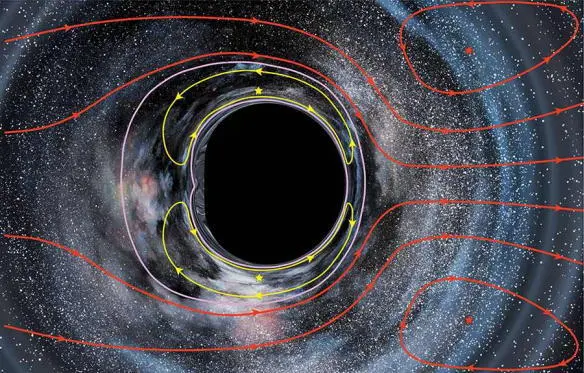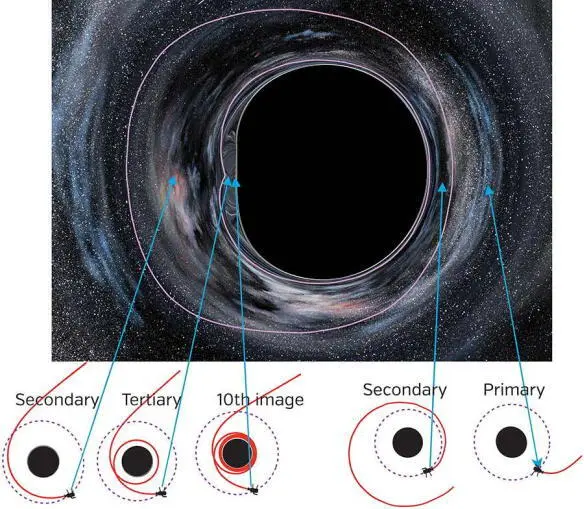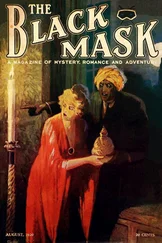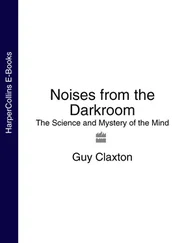Now, if you’re ready, think through the subsequent motions of the images, depicted in Figure 8.4.
Lensing by a Rapidly Spinning Black Hole: Gargantua
The whirl of space generated by Gargantua’s very fast spin changes the gravitational lensing. The star patterns in Figure 8.1 (Gargantua) look somewhat different from those in Figure 8.4 (a nonspinning black hole), and the streaming patterns differ even more.
For Gargantua the streaming (Figure 8.5) reveals two Einstein rings, shown as pink curves. Outside the outer ring, the stars stream rightward (for example, along the two red curves), as they did for a nonspinning black hole in Figure 8.4. However, the whirl of space has concentrated the stream into narrowed high-speed strips along the back edge of the hole’s shadow, strips that bend somewhat sharply at the equator. The whirl has also produced eddies in the streaming (the closed red curves).
The secondary image of each star appears between the two Einstein rings. Each secondary image circulates along a closed curve (for example, the two yellow curves), and it circulates in the opposite direction to the red streaming motions outside the outer ring.

Fig. 8.5. The star streaming patterns as seen by a camera near a rapidly spinning black hole such as Gargantua. In this simulation by the Double Negative visual-effects team, the hole spins at 99.9 percent of the fastest possible, and the camera is in a circular, equatorial orbit with circumference six times larger than the horizon’s circumference. For a film clip of this simulation, see this book’s page at Interstellar.withgoogle.com.
There are two very special stars in Gargantua’s sky with gravitational lensing turned off. One lies directly above Gargantua’s north pole; the other directly below its south pole. These are analogs of the star Polaris, which resides directly above the Earth’s north pole. I placed five-pointed stars at the primary (red) and secondary (yellow) images of Gargantua’s pole stars. All the stars on the Earth’s sky appear to circulate around Polaris as we humans are carried around by the Earth’s rotation. Similarly, all of Gargantua’s primary stellar images circulate around the red pole-star images as the camera orbits the hole, but their circulation paths (for example, the two red eddy curves) are highly distorted by the whirl of space and gravitational lensing. Similarly, all the secondary stellar images circulate around the yellow pole-star images (for example, along the two distorted yellow curves).
Why, for a nonspinning hole (Figure 8.4), did the secondary images appear to emerge from the black hole’s shadow, swing around the hole, and descend back into the shadow, instead of circulating around a closed curve as for Gargantua (Figure 8.5)? They actually do circulate around closed curves for a nonspinning hole. However, the inner edge of the closed curve is so close to the shadow’s edge that it can’t be seen. Gargantua’s spin makes space whirl, and that whirl moves the inner Einstein ring outward, revealing the secondary images’ full circulatory pattern (yellow curves in Figure 8.5), and revealing the inner Einstein ring.
Inside the inner Einstein ring, the streaming pattern is more complicated. The stars in this region are tertiary and higher-order images of all the stars in the universe—the same stars as appear as primary images outside the outer Einstein ring and secondary images between the Einstein rings.
In Figure 8.6, I show five small pictures of Gargantua’s equatorial plane, with Gargantua itself in black, the camera’s orbit in dashed purple, and a light ray in red. The light ray brings to the camera the stellar image that is at the tip of the blue arrow. The camera is moving counterclockwise around Gargantua.
You can get a lot of insight into the gravitational lensing by walking yourself through these pictures, one by one. Take note: The actual direction to the star is upward and rightward (see outer ends of the red rays). The camera and beginning of each ray point toward the stellar image. The tenth image is very near the left edge of the shadow and the right secondary image is near the right edge; comparing the directions of the camera for these images, we see that the shadow subtends about 150 degrees in the upward direction. This despite the fact that the actual direction from camera to center of Gargantua is leftward and upward. The lensing has moved the shadow relative to Gargantua’s actual direction.

Fig. 8.6. Light rays that bring images of the stars at the tips of the blue arrows. [From the same Double Negative simulation as Figures 8.1 and 8.5.]
Creating Interstellar ’s Black-Hole and Wormhole Visual Effects
Chris wanted Gargantua to look like what a spinning black hole really looks like when viewed up close, so he asked Paul to consult with me. Paul put me in touch with the Interstellar team he had assembled at his London-based visual-effects studio, Double Negative.
I wound up working closely with Oliver James, the chief scientist. Oliver and I talked by phone and Skype, exchanged e-mails and electronic files, and met in person in Los Angeles and at his London office. Oliver has a college degree in optics and atomic physics and understands Einstein’s relativity laws, so we speak the same technical language.
Several of my physicist colleagues had already done computer simulations of what one would see when orbiting a black hole and even falling into one. The best experts were Alain Riazuelo, at the Institut d’Astrophysique in Paris, and Andrew Hamilton, at the University of Colorado in Boulder. Andrew had generated black-hole movies shown in planetariums around the world, and Alain had simulated black holes that spin very, very fast, like Gargantua.
So initially I planned to put Oliver in touch with Alain and Andrew and ask them to provide him the input he needed. I lived uncomfortably with that decision for several days, and then changed my mind.
During my half century physics career I put great effort into making new discoveries myself and mentoring students as they made new discoveries. Why not, for a change, do something just because it’s fun, I asked myself, even though others have done it before me? And so I went for it. And it was fun. And to my surprise, as a byproduct, it produced (modest) new discoveries.
Using Einstein’s relativistic laws of physics and leaning heavily on prior work by others (especially Brandon Carter at the Laboratoire Univers et Théories in France and Janna Levin at Columbia University), I worked out the equations Oliver needed. These equations compute the trajectories of light rays that begin at some light source, for example, a distant star, and travel inward through Gargantua’s warped space and time to the camera. From those light rays, my equations then compute the images the camera sees, taking account not only of the light’s sources and Gargantua’s warping of space and time, but also the camera’s motion around Gargantua.
Having derived the equations, I implemented them myself, using user-friendly computer software called Mathematica . I compared images produced by my Mathematica computer code with Alain Riazuelo’s images, and when they agreed, I cheered. I then wrote up detailed descriptions of my equations and sent them to Oliver in London, along with my Mathematica code.
Читать дальше














